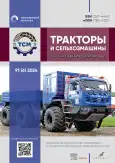Моделирование рабочего процесса газодизеля, работающего на аммиаке с добавкой водорода
- Авторы: Галышев Ю.В.1, Синьяо Л.1, Абызов О.В.1, Зайцев А.Б.1
-
Учреждения:
- Санкт-Петербургский политехнический университет Петра Великого
- Выпуск: Том 91, № 6 (2024)
- Страницы: 748-759
- Раздел: Теория, конструирование, испытания
- URL: https://bakhtiniada.ru/0321-4443/article/view/283049
- DOI: https://doi.org/10.17816/0321-4443-635228
- ID: 283049
Цитировать
Полный текст
Аннотация
Обоснование. Аммиак, как безуглеродное топливо, привлекает большое внимание исследователей разных стран и считается одним из перспективных альтернативных топлив, обеспечивающих сокращение выбросов парниковых газов. Несмотря на то, что свойства аммиака широко изучены, практическое применение этого вида топлива остаётся затруднительным. Необходимы дополнительные исследования для преодоления проблем, включая низкую скорость горения, высокий выброс оксидов азота и несгоревшего аммиака. Для стимулирования процесса сгорания в цилиндре в качестве активатора горения аммиачно-воздушной смеси возможно использовать добавку водорода. Данная статья направлена на расчётное исследование влияния замещения дизельного топлива аммиаком на характеристики и вредные выбросы двигателя внутреннего сгорания.
Цель работы — расчётное исследование рабочего процесса и вредных выбросов с отработавшими газами автотракторного газодизеля при работе на аммиаке с добавкой водорода.
Методы. В качестве объекта исследования выбран современный автотракторный дизельный двигатель ЯМЗ-53415. Расчёты проводились для номинального режима работы двигателя.
Для трёхмерного моделирования рабочего процесса газодизельного двигателя, работающего на аммиаке с добавкой водорода, использовался программный комплекс Ansys Forte, который разработан на основе современных теоретических представлений о физике трёхмерных потоков газа и жидкости, динамике распыления топлива и процессах сгорания.
Результаты и обсуждение. Расчет рабочего процесса газодизеля, работающего на аммиаке с различной запальной дозой дизельного топлива, показал, что при уменьшении дозы дизельного топлива со 100% до 5% сохраняется мощность и кпд двигателя, максимальное давление в цилиндре снижается на 26%, выбросы оксидов азота и количество несгоревшего аммиака увеличиваются. Расчет рабочего процесса газодизеля, работающего на аммиаке с добавкой водорода, позволил определить минимальную добавку водорода, обеспечивающую полное сгорание аммиака.
Заключение. Работа газодизеля на аммиаке приводит к значительному снижению выбросов углекислого газа, более чем на порядок, т. е. аммиак может стать альтернативой углеводородному топливу для достижения углеродной нейтральности.
Применение небольшой добавки водорода — 0,4% позволяет значительно увеличить скорость сгорания аммиачно-воздушной смеси и обеспечивает практически полное сгорание аммиака.
Выбросы оксидов азота при замещении дизельного топлива аммиаком увеличиваются более чем в два раза. Для их снижения необходимо использовать известные способы — рециркуляцию отработавших газов, SCR-нейтрализатор.
Ключевые слова
Полный текст
Открыть статью на сайте журналаОб авторах
Юрий Виталиевич Галышев
Санкт-Петербургский политехнический университет Петра Великого
Автор, ответственный за переписку.
Email: galyshev57@yandex.ru
ORCID iD: 0000-0001-7915-0623
SPIN-код: 8258-1827
д-р техн. наук, профессор Высшей школы энергетического машиностроения Института энергетики
Россия, Санкт-ПетербургЛо Синьяо
Санкт-Петербургский политехнический университет Петра Великого
Email: losinyao181031@gmail.com
ORCID iD: 0009-0005-2815-7231
аспирант Высшей школы энергетического машиностроения Института энергетики
Россия, Санкт-ПетербургОлег Витальевич Абызов
Санкт-Петербургский политехнический университет Петра Великого
Email: oleg.abyzov@yandex.ru
ORCID iD: 0000-0001-9898-4279
SPIN-код: 3068-4970
канд. техн. наук, доцент Высшей школы энергетического машиностроения Института энергетики
Россия, Санкт-ПетербургАлексей Борисович Зайцев
Санкт-Петербургский политехнический университет Петра Великого
Email: abzaytsev@mail.ru
ORCID iD: 0000-0002-7443-1909
SPIN-код: 8443-3030
канд. техн. наук, доцент Высшей школы энергетического машиностроения Института энергетики
Россия, Санкт-ПетербургСписок литературы
- Fadhil Y Al-Aboosi, Mahmoud M El-Halwagi, Margaux Moore, et al. Renewable ammonia as an alternative fuel for the shipping industry. Current Opinion in Chemical Engineering. 2021;31. doi: 10.1016/j.coche.2021.100670
- Nadimi E, Przybyła G, Lewandowski M T, et al. Effects of ammonia on combustion, emissions, and performance of the ammonia/diesel dual-fuel compression ignition engine. Journal of the Energy Institute. 2023;107. doi: 10.1016/j.joei.2022.101158
- Abyzov OV, Galyshev YV, Metelev AA, et al. Computational Study of Combustion and Emissions Characteristics in Ammonia-Powered Gas-Diesel Engine. In: Radionov AA, Gasiyarov VR. (eds) Proceedings of the 9th International Conference on Industrial Engineering. ICIE 2023. Lecture Notes in Mechanical Engineering. Cham: Springer; 2023. doi: 10.1007/978-3-031-38126-3_34
- Abyzov OV, Galyshev YuV, Ivanov AK, et al. Modeling of the Indicator Process of the Automobile Gas Engine during its Operation with Ammonia. Engines Construction. 2023;1(291):64–69. (In Russ.) doi: 10.18698/jec.20231.64-69
- Abyzov OV, Galyshev YuV, Metelev AA. Study of the working process of a gas-diesel engine using ammonia as a main fuel. Turbines and Diesels. 2023;4(109):58–64. (In Russ.)
- Kuleshov AS, Kuleshov AA, Markov VA, et al. Computational Studies of Parameters of Working Process of Diesel Engine with Ammonia Additives in the Intake System. Engines Construction. 2023;3(293):71–93. (In Russ.) doi: 10.18698/jec.2023.3.71-93
- Sa Bowen, Liu Ying, Markov VA, et al. Combustion Process Characteristics and Ecological Indicators of the Two-Fuel Diesel Engine Running on Ammonia. Engines Construction. 2023;4(294):73–87. (In Russ.) doi: 10.18698/jec.2023.4.73-87
- Solutions MAN Energy. MAN B&W two-stroke engine operating on ammonia. 2021. Accessed: 17.08.2024. Available from: www.man-es.com.
- Reiter AJ, Kong SC. Combustion and emissions characteristics of compression-ignition engine using dual ammonia-diesel fuel. Fuel. 2011;90(1):87–97. doi: 10.1016/j.fuel.2010.07.055
- Li J, Lai S, Chen D, et al. A review on combustion characteristics of ammonia as a carbon-free fuel. Frontiers in Energy Research. 2021;9. doi: 10.3389/fenrg.2021.760356
- Karagöz Y, Sandalcı T, Yüksek L, et al. Effect of hydrogen–diesel dual-fuel usage on performance, emissions and diesel combustion in diesel engines. Advances in Mechanical Engineering. 2016;8(8). doi: 10.1177/1687814016664458
- Nag S, Dhar A, Gupta A. Hydrogen-diesel co-combustion characteristics, vibro-acoustics and unregulated emissions in EGR assisted dual fuel engine. Fuel. 2022;307. doi: 10.1016/j.fuel.2021.121925
- Verhelst S, Wallner T. Hydrogen-fueled internal combustion engines. Progress in energy and combustion science. 2009;35(6):490–527. doi: 10.1016/j.pecs.2009.08.001
- Castro N, Toledo M, Amador G. An experimental investigation of the performance and emissions of a hydrogen-diesel dual fuel compression ignition internal combustion engine. Applied Thermal Engineering. 2019;156(6):660–667. doi: 10.1016/j.applthermaleng.2019.04.078
- Dimitriou P, Kumar M, Tsujimura T, et al. Combustion and emission characteristics of a hydrogen-diesel dual-fuel engine. International journal of hydrogen energy. 2018;43(29):13605–13617. doi: 10.1016/j.ijhydene.2018.05.062.
- Szwaja S, Grab-Rogalinski K. Hydrogen combustion in a compression ignition diesel engine. International journal of hydrogen energy. 2009;34(10):4413–4421. doi: 10.1016/j.ijhydene.2009.03.020
- Wang B, Yang C, Wang H, et al. Effect of Diesel-Ignited Ammonia/Hydrogen mixture fuel combustion on engine combustion and emission performance. Fuel. 2023;331. doi: 10.2139/ssrn.4179242
- Leilei X, Chang Y, Treacy M, et al. A Skeletal Chemical Kinetic Mechanism for Ammonia/N-Heptane Combustion. Fuel. 2022;331(4). doi: 10.1016/j.fuel.2022.125830
Дополнительные файлы
















